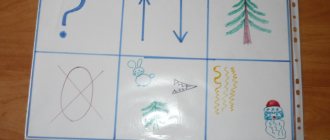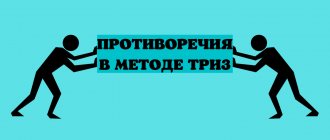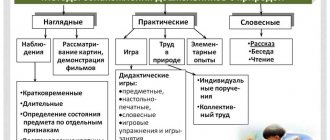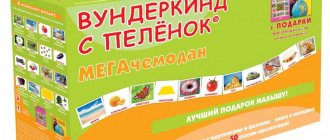Geometric puzzle games are very useful for developing children's spatial concepts, constructive thinking, logic, imagination and intelligence. One of these games is the ancient Chinese game TANGRAM. She was born in China 3000 years ago. From the 7 elements into which the square is divided, you can create many different objects and animal figures.
Cutting template
For ease of use, we will take the black and white version. It is convenient to print it or draw it yourself. It is better to do this on thick paper or cardboard. Then the square must be carefully cut along the lines.
To begin, ask your child to make a square out of these pieces. It is better if the child completes the task without looking at the drawing of the square. But if it doesn’t work out, then of course you can use the sample.
A variety of silhouettes are created from tangram elements. It is easier for a child to do this using samples with drawn components. Outline patterns are more difficult to reproduce.
Recommendations.
When introducing children to the Columbus Egg games, it is necessary to maintain consistency in complexity, coordinating it with the individual capabilities of the children. Management techniques are aimed at nurturing children's interest in games and teaching them practical skills in reproducing figures. In case of difficulty, the teacher offers a sample made on the same scale as the parts of the game, indicating the location of the 1st and 2nd parts. In this case, when choosing figures, children place them on the sample. Throughout the work, the teacher points out the need to mentally imagine the figure, divide its shape and structure into its component parts, and then reproduce it.
Tangram game rules
In the game of tangrams, the following rules must be observed:
- When composing images, the entire set of parts is used as a whole;
- The parts of the geometric constructor are attached to each other;
- You cannot overlap parts on top of each other.
Riddles can make the TANGRAM game even more interesting.
I bring to your attention a few pages from my book. Guessing riddles and, at the same time, constructing a solution from tangram elements perfectly develops logical, visual-figurative and spatial thinking.
Traditional heritage of Mongolian national games
There is a historical tradition in Mongolia: the ancestors of modern Mongols used proverbs, instructions, fairy tales and legends, songs and music, glorification, various games, and entertainment in raising children and the younger generation. Among them there are many games that develop dexterity, stamina, and strength in children and adolescents. National games not only educate, but also have educational significance. From the games inherited from their ancestors, children receive concepts about their homeland, everyday life, work, life, morality, and customs. The peculiarity of Mongolian folk games is that they reflect the life and way of life of the Mongolian people. The Mongols respectfully spoke about Shagaa - the talus bones: “Although they are the size of a finger, they have four honorable names,” and they played everything from small to large.
Written in 1240, “The Hidden Legend of the Mongols” not only reflects the way of life of that time, but is also a valuable object of historical heritage. It says about “Shagaa” this way: “At that time, Zhamukh gave one shagaa of a wild goat as a sign of friendship and the two of them played talus on the ice of the Onon River.” This fact proves that the Mongols played talus back in the 13th century.
Mongolian games have certain rules; games for children and youth are strictly different. Some games are convenient for playing at certain times of the year, some spread from one region to another, acquire local rules, adapt to local customs, thereby becoming even more enriched and becoming truly national creativity. The people discovered reasonable ways to educate future generations, came up with many interesting games, developing and enriching them over the years, even now they have not lost their value, being part of the methodology for raising and developing children [2,3].
The two-volume book by N. Namzhildorj, published in 1963, mainly reflects the features of board games; it also includes games that are an important means of developing the mind and thinking of children. In addition, these volumes include many dozens of games that the Mongols played for many centuries. These are games such as “Morin uraldaan” (Horse racing), “Khurdan mor” (Fast horse), “Arvan lived” (Twelve years), “Durbun khoshuu malyn za bodoh” (Caring for four types of domestic animals), etc. There are many games that reflect national characteristics, Mongolian life, features of life and the economy. And even now, in educational work with children, collections of Mongolian national children’s games are used: “Shagain togloom” (Talus bone games) by Ch. Chuluun, “Mongolin hologt togloom” (Mongolian board games) by N. Namzhildorzh, “Dargangyn huuhdiin togloom” (Children's games Dariganga) G. Sukhebator.
Types and content of Mongolian national games
. Mongolian national games are well suited to the peculiarities of life of the Mongolian people: mobile, uncomplicated, and fully meet the requirements of children's and youth games. Games can be divided into the following types:
— Word games. These games are divided into: developing breathing with the help of tongue twisters, games for composing words and sentences, fortune telling games, wisdom competitions, finger games. For example: “Muur khulgana” (Game of cat and mouse), “Sumber uul” (Build Mount Sumber), “Tsagaan temeetseh” (Game of white camels), “Khuh buh” (Game of larks), “Khul tooloh” ( Game of counting rhymes), “Shar shuvuu tsaylah” (Owl’s Lunch).
- Board games. “Shagaa” - astragal bones on boards: “Uuchuur”, “Buga” (Deer), “Chuu chamay” (Barely), “Tugal” (Calves), etc.
— Prefabricated and construction games. Clockwork wooden ones, untying knots, games of loops made of irises, ropes, belts, threads. For example: “Modon ons” (Knot made of wood), “Garkhin tsoozh” (Locks made of rings). Games made from threads: “Ongots” (Airplane), “Khudag” (Well), “Ukhriin nud” (Currant), “Geriin haalga” (Yurt Door), “Toono” (Dome), “Shuvuuny Khul” (Bird’s Legs) ; from irises: “Gudas” (Mattress), “Olbog” (Knitting a seat mat), etc.
— Outdoor games: “Tsuu hayah” (Find a discarded ball in the dark), “Nuugdah” (Hide and Seek), “Muur Khulgana” (Cat and Mouse), “Zhanch chuluu tsokhikh” (Hit a stone), “Zakh tsokhikh” (Hit region), “Mor uraldakh” (Horse racing), “Bukh-barildakh” (Wrestling), “Sur harvakh” (Archery). Outdoor games develop children's reaction, dexterity, intelligence, and resourcefulness.
Mongolian folk games are multifaceted in appearance and content.
Games should arouse interest in children, satisfy their cognitive needs, be accessible to perform, provide physical development, develop the psyche and imagination, speech abilities, teach children customs, help children master primary knowledge of their native language and mathematics.
Mongolian national games are characterized by content, pedagogical and educational roles, rules and gaming activities. Games reflect the customs, traditions and life of the people. A feature of the content of Mongolian folk games is the reflection of livestock life, the life and daily life of shepherds, customs, and local features. For example, in the game “Zhinchin” (Caravan), children learn how the inhabitants of the Gobi make transportation using camel caravans, how to care for camels, herd them, learn to distinguish the sex of camels, name accessories and means for caravans, what they are made of , shows how shepherds communicate with each other, the purpose of various specific sounds, such as, for example, “toor toor” (the sound made when milking a camel to improve milk yield), “hoog hoog” (a sound intended to urge camels), “ coog coog" (a sound intended to make a camel sit down), "haa haa" (a prohibitory signal), etc. The content of all Mongolian games has common features, but each nationality reflects its traditions and customs. Mongolian national games play an important educational and pedagogical role.
The educational and pedagogical role of Mongolian national verbal games is aimed at the following:
1. Teaching children to correctly pronounce sounds
2. Enriching children's vocabulary
3. Development of verbal abilities in children
The educational and pedagogical role of Mongolian national games with numerical content is aimed at the following:
1. Acquiring the concept of numbers
2. Gain knowledge about ordinal numbers and acquire concepts of many and small
3. Acquiring the concept of the structure and composition of numbers.
4. Mastering the operations of addition and subtraction
5. Acquiring the concept of space.
Mongolian national outdoor games such as “Tsagaan temeetseh” (Game of white camels), “Chono tarvaga” (Game of wolf and tarbagan), “Budag zarah” (Game of selling paints), “Muur Khulgana” (Game of cat and mouse) , “Udur Shono” (Game of day and night), “Ezenguy bair” (Game of empty space), “Nuhguy tuulai” (Game of rabbits without holes), etc. are exercises for developing children’s native speech, acquiring the concept about numbers, acquiring harmony of movements, correct gait, developing running, throwing, jumping skills. Along with this, while playing, children acquire courage, dexterity, and gain friendship skills [1].
In any national games, rules .
The rules of the games perform the following roles:
1. Express the content of the game
2. Determine the educational and pedagogical role
3. Indicate the order and action of the game
4. Establish the procedure for applying prohibitions.
It has been proven that stimulation of the central nervous system of children is more important than its delay. Therefore, children are easily excited and cannot sufficiently coordinate their actions. It is useful to use games with restrictions and established order. The rules of the game help children restrain themselves and control themselves.
Children are primarily very interested in play activities
. It activates children and encourages them to want to play. In addition, gaming activities have an educational and pedagogical function. Games for young children have simple and basic rules. Young children are not interested in gaming goals; their interests are aimed specifically at gaming activities. They want, for example, to run, run away, spread their talus bones, etc. The games of older children are mainly in the form of competition and rivalry.
Outdoor games
are an important physical education tool that develops the physical condition of children and develops their motor skills. Outdoor games give children not only motor skills, skills of proper walking, running, throwing, jumping, but also the ability to overcome difficulties, contribute to the acquisition of courage, dexterity, reaction, friendship and interaction skills, and this greatly helps to create a team.
Outdoor games are mainly played in the fresh air and therefore have a beneficial effect on the health of children, make them healthier, and improve the functioning of the child’s body. Outdoor games, in their content, cover various movements; playing games in a competitive form increases children's interest and teaches them collective activity. It is convenient to include outdoor games in any part of classes; they can be done during breaks and in free time from classes. During the games, the teacher needs to actively participate in the game. By playing outdoor games, children not only acquire the ability to imagine and determine the rules, content, and form of games, but also learn dexterous movements. Outdoor games can be classified as: games with a high, medium and low level of mobility. Materials and objects of games must meet hygiene requirements and be suitable for the age characteristics of children. Before the game, the teacher clearly explains the rules of the game. In outdoor games, gestures are important and therefore it is necessary to familiarize students with game gestures well. Games are divided into types depending on how movements during play affect children’s bodies:
1. Games that develop the general physical development of children
2. Outdoor games with elements of running, jumping and throwing
3. Games that develop children's motor skills
Outdoor games occupy 40–60% of physical education and health lessons taught in primary school. Outdoor games are important for the systemic development of the physiological functioning of children’s bodies. Outdoor games educate children and teach them to be attentive, proactive, capable, and organized. Along with this, by playing outdoor games, children not only learn to easily determine the content and forms of games, acquire visual skills, but also acquire the ability to avoid obstacles, jump and run. Games are also used as an educational and pedagogical form.
In order to instill in children the appropriate knowledge and skills, teachers and educators need to effectively conduct a combination of direct and indirect training. When conducting an outdoor game, the teacher will first line up the children in one row and announce the name of the game that the children will play. After which he explains the rules of the game and talks about its meaning. Then he divides the children into teams, following the rules and instructions, selects team captains, a game leader, prepares objects and materials used in the game, the room and area for the game. Games should be played depending on the age, motor skills of children, acquired skills, goals, connection to techniques, elements and exercises.
The teacher divides the children into teams in the following ways:
1. By gender; 2. By number; 3. Optional; 4. By selection; 5. By name; 6. According to one’s strength (in order to equalize opportunities); 7. Based on the results of the discussion; 8. Alternating (girls, boys).
The selection of the team captain and game manager can occur in the following ways:
1. Voluntary; 2. By encouragement; 3. Nomination; 4. Call directly by names; 5. Selecting students with appropriate motor skills and abilities.
Also, outdoor games have some features that distinguish them from other games:
1. Features of movements: 2. Game form; 3. Number of players; 4. Materials and objects used.
Outdoor games are an important learning tool with their own specifics.
Based on the results of the study on the topic of Mongolian national games, the authors came to the following conclusions:
1. It is necessary to widely use games in raising and teaching children
2. Games must be selected depending on the age and psyche of the children.
3. Teachers need to carefully study national games, develop game methods, and use them as an important means for the comprehensive development of children.
4. It is necessary to create a diverse material base with opportunities for play.
5. It is necessary to educate parents, especially young ones, about Mongolian national games. To do this, you need to properly advertise various national games, use scientifically based methods in the upbringing and training of young children.
Literature:
1. Altantsetseg L. Development of regional programs for physical education based on a comparative analysis of the results of morpho-functional and physical preparedness of schoolchildren in various aimags of Mongolia // L. Altantsetseg. Theory and practice of physical culture - M., 2013, No. 8. - P 21
2. Lkhagvasuren G. History of physical culture - Ulaanbaatar.: Admon, 2000. - 350 huud.
3. Lkhagvasuren G. Mongolian national sports and games / Lkhagvasuren G. -Ulaanbaatar: Admon. 2004. - 400 p.



